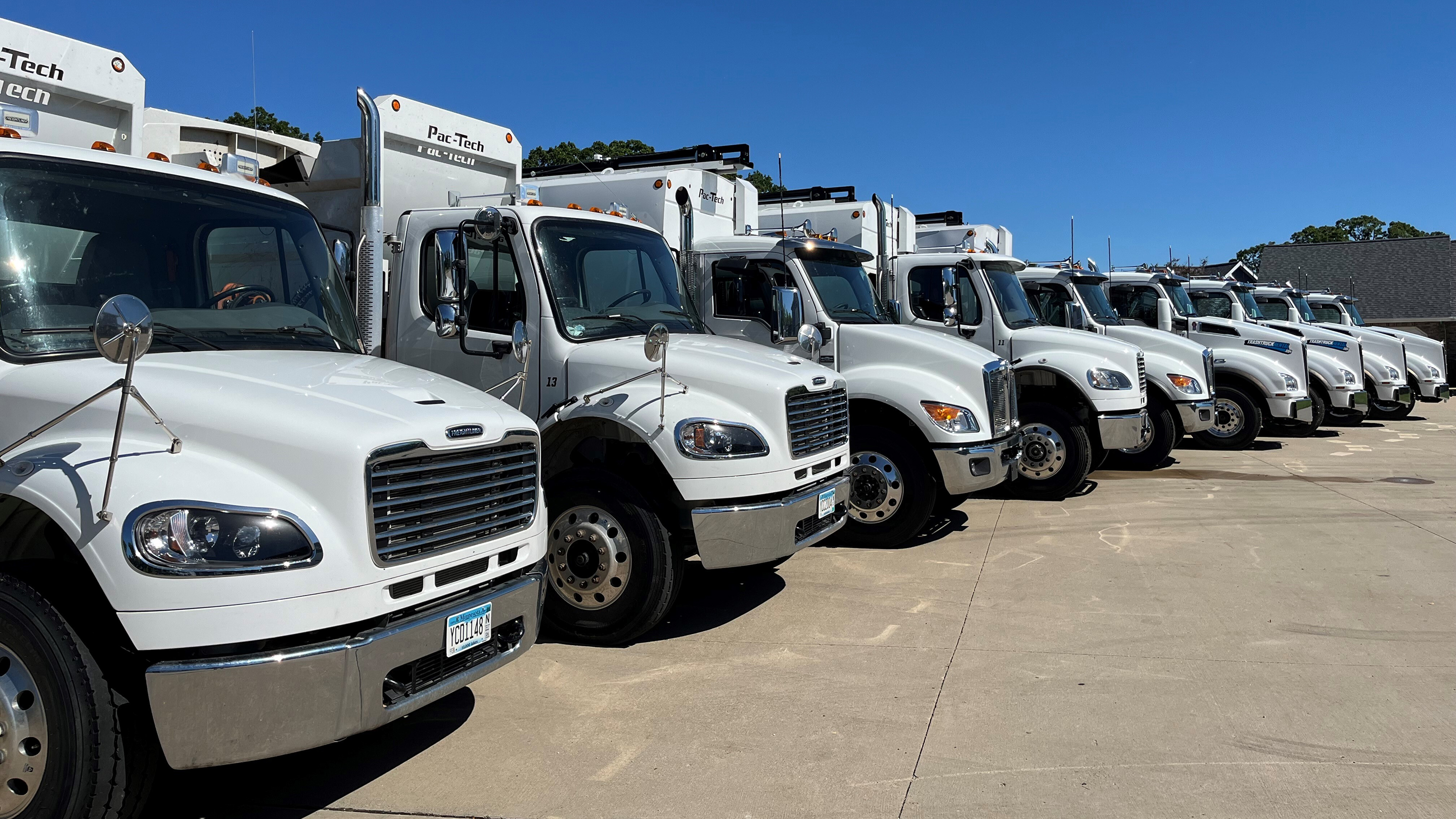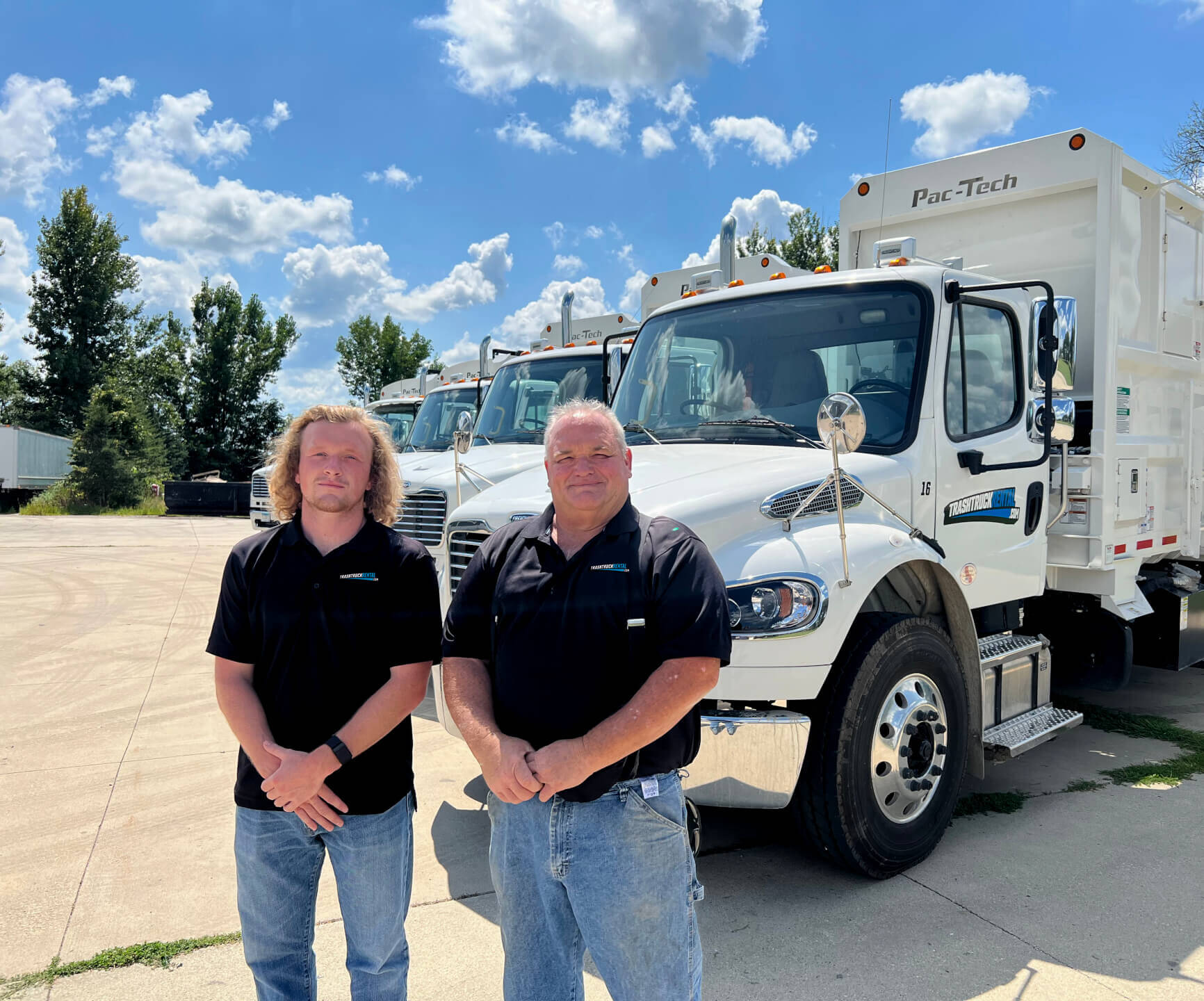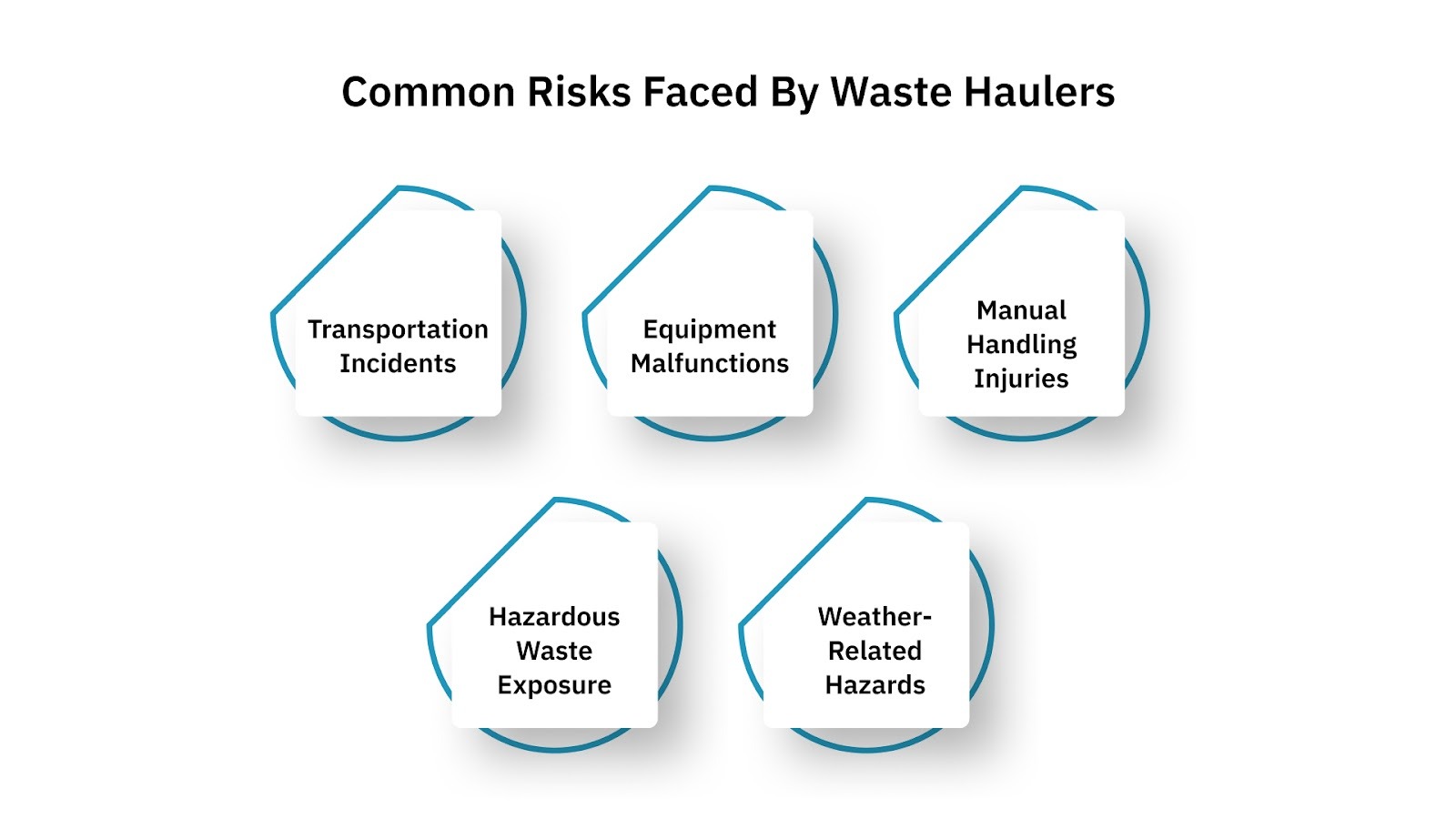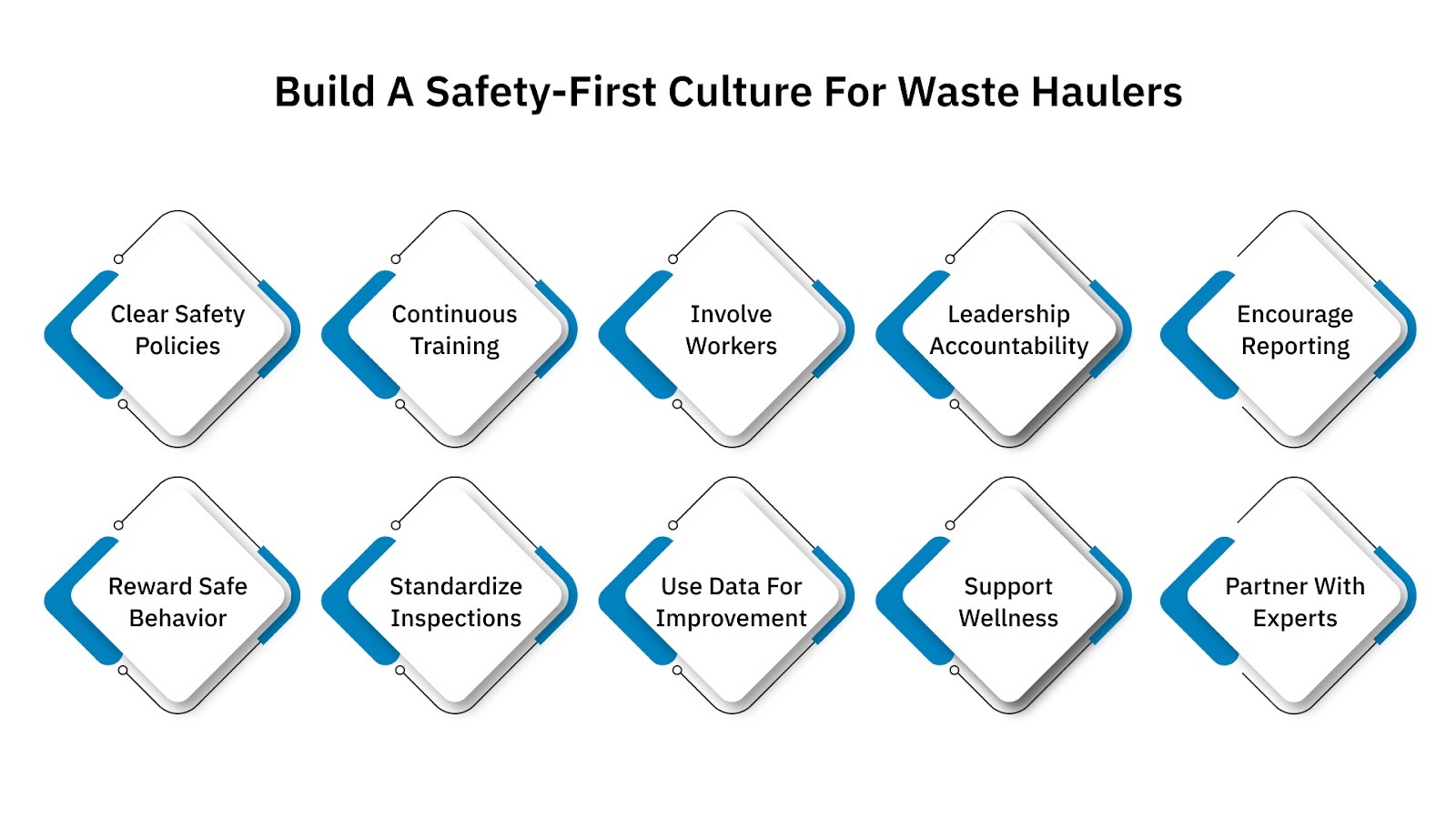Waste Hauler Safety Guidelines for Municipal Teams
Improve waste hauler safety with PPE, regular training, equipment checks, and proper material handling. Click here for essential tips!

Improve waste hauler safety with PPE, regular training, equipment checks, and proper material handling. Click here for essential tips!


What steps are you taking to protect your municipal waste collection teams?
The Bureau of Labor Statistics reported 5,283 fatal work injuries across all U.S. occupations in 2023. The country has a fatality rate of 3.5 per 100,000 full-time workers. This scenario highlights the urgent need for strong waste hauler safety practices.
Without strict guidelines, operations risk accidents, legal challenges, and costly delays. Waste collection will always involve hazards, but your approach determines whether risks are reduced or magnified.
In this guide, you will learn practical safety guidelines, proven training methods, and modern strategies that help municipal teams build a stronger safety culture.
When you manage municipal waste operations, safety is not optional. Your teams face moving traffic, heavy equipment, unpredictable loads, and tight schedules. A single lapse can result in injuries or downtime that affects entire communities. Waste hauler safety protects workers and the services residents depend on.
You also face increasing regulatory pressure. Federal and state agencies expect strict compliance with safety standards. Any failure may bring fines, lawsuits, or damaged public trust. At the same time, rising insurance costs make proactive safety planning even more valuable for your operations.
Building a safety-first culture ensures crews return home safely while maintaining reliable services. Waste hauler safety is not just about compliance; it directly supports operational stability and public accountability. Understanding how the industry is performing today provides context for improving your own safety approach.
Municipal waste collection remains one of the most hazardous jobs in the country. Understanding industry trends helps you recognize where safety improvements are essential.
The following statistics highlight the current state of waste hauler safety:
These numbers make it clear that waste hauler safety requires more than routine measures. They provide context for the common risks your teams encounter in day-to-day operations.

Every shift your team completes carries risks that go beyond physical strain. Waste collection involves long hours in traffic, handling unpredictable materials, and relying on heavy machinery. Without strong precautions, these conditions expose workers to serious hazards. Addressing these risks is central to improving waste hauler safety.
Here are the 5 most common risks your teams may face:
Most refuse-truck fatalities come from traffic-related events. Workers face struck-by hazards while loading waste or collisions with other vehicles during routes. To reduce risks, train drivers on defensive driving, enforce strict blind spot checks, and invest in trucks with advanced safety systems. These steps lower exposure and improve route safety.
Hydraulic lifts, compactors, and automated arms can fail or misfire, creating life-threatening situations. Regular maintenance, documented inspections, and proper lockout/tagout procedures reduce these risks. Training workers to recognize warning signs in equipment performance also helps prevent accidents and downtime.
Repeated lifting, pushing, and pulling lead to musculoskeletal injuries over time. Poor posture or rushing during pickups makes the issue worse. You can reduce strain by training proper lifting techniques, rotating tasks across teams, and using carts or assisted devices wherever possible.
Workers often encounter chemicals, sharps, or improperly disposed of medical waste mixed with municipal garbage. Exposure risks increase without clear sorting and protective gear. Provide teams with PPE, clear handling rules, and quick access to washing stations. Reinforcing waste classification rules with businesses and households also lowers exposure.
Snow, rain, and extreme heat create unsafe working conditions for drivers and collectors. Slippery streets raise crash risks, while heat stress affects concentration and stamina. You can manage these risks by adjusting schedules, enforcing hydration breaks, and equipping trucks with climate-ready gear.
Related Article: Essential Truck Driving Tips for Winter Weather
Understanding these risks helps you build targeted training, improve routes, and invest in safer equipment. Taking them seriously is important to advancing waste hauler safety and building a stronger safety-first culture for your municipal teams.

Creating a safety-first culture requires more than protective gear and compliance checklists. It means including safe practices in every decision, from training new hires to planning routes. When safety becomes part of your team’s identity, workers are more alert, confident, and dependable. Waste hauler safety grows stronger when you focus on habits, systems, and communication.
Here are 10 proven ways to build a lasting safety-first culture:
Written policies give your team direction and accountability. Outline procedures for vehicle use, personal protective equipment, reporting hazards, and responding to incidents. When policies are clear and consistent, they guide workers to make safer choices on every route and shift.
One-time training sessions lose impact quickly. Ongoing education keeps workers aware of updated rules, new equipment, and real-life lessons from recent incidents. Use workshops, refreshers, and short daily safety talks to build a culture of learning that reinforces waste hauler safety across your crews.
Recommended Reading: Essential Safety Tips for Garbage Truck Drivers and Companies
Workers see risks firsthand. Involving them in safety meetings and route planning gives you practical input. When employees feel their voice matters, they follow rules more closely. This inclusion also creates a shared sense of responsibility for safe operations.
Supervisors and managers must model safe behavior. When leaders wear PPE, check vehicles, and enforce policies, crews take safety seriously. Leadership accountability makes safety expectations non-negotiable, shaping the workplace culture from the top down.
Workers must feel safe to report hazards, near-misses, or unsafe practices without fear of blame. A simple reporting process builds trust and helps you address risks before they become accidents. Reward transparency to keep communication strong and consistent.
Acknowledging workers who follow protocols builds motivation. Rewards can include recognition during meetings, small incentives, or career growth opportunities. Positive reinforcement turns safety into a goal teams want to achieve, not a rule they are forced to follow.
Further Insights: Waste Vehicle Safety Tips and Guidelines
Add pre-trip and post-trip inspection with documented checklists. This habit catches issues before they lead to failures on the road. Making inspections routine also sends a clear message: vehicle readiness is essential to waste hauler safety and team reliability.
Accident logs, inspection reports, and near-miss records provide patterns you can act on. Analyze data to see where risks repeat, then adapt training, routes, or policies. Data-driven improvements move safety from reactive fixes to proactive planning.
Fatigue, dehydration, and stress reduce alertness on the job. Offering health programs, hydration breaks, and manageable schedules improves focus and decision-making. A healthier workforce is naturally safer and more consistent in its performance.
External experts bring fresh knowledge and proven practices. Partner with trainers, regulators, and industry groups to benchmark your processes. Access to specialized knowledge helps you improve systems and sustain a safety-first culture long term.
Must Read: Troubleshooting Common Rear Loader Garbage Truck Problems
A culture built on these habits creates safer, more reliable waste hauler operations. With these steps, your teams can work confidently while reducing risks. Building this culture also connects naturally to how modern rental solutions can support safety in municipal operations.
Trash Truck Rental is a family-owned business with more than 20 years in the waste removal industry. Based in Minnesota, we provide nationwide trash truck rentals, sales, and leasing services designed for municipalities and waste management teams that need reliable and flexible solutions.
Here’s how our services support safety in municipal operations:
Are equipment shortages, costly downtime, or outdated trucks affecting your team’s safety? Connect with us today for reliable rental solutions that keep your municipal operations running safely and efficiently.
Waste hauler safety matters for every municipal team, from supervisors to drivers and loaders. The demanding nature of waste collection exposes crews to physical risks, road hazards, and unpredictable environments. Prioritizing safety is not just about compliance; it’s about protecting lives, building trust, and ensuring smoother daily operations.
The common risks faced by waste haulers are serious and recurring. Transportation-related incidents, struck-by accidents, equipment malfunctions, exposure to hazardous waste, and musculoskeletal injuries are among the leading causes of injuries and fatalities. These dangers highlight why municipal leaders cannot treat safety as an afterthought.
Municipal teams can create a safety-first culture by investing in comprehensive training, including PPE use, maintaining equipment properly, encouraging open communication, and conducting regular safety audits. Open reporting, improving route planning, and using technology also make a measurable difference in reducing risks.
Are you ready to strengthen waste hauler safety in your municipal operations?
Waste hauler safety isn’t optional; it’s a responsibility.
Partner with Trash Truck Rental to secure your teams and keep your community moving forward.
Prioritize daily vehicle inspections, require PPE, and train staff on safe lifting, route planning, and defensive driving. Use automated collection when possible, document near-misses, and keep equipment well-maintained. Regular drills and an open reporting culture reduce risks.
Inspect refuse trucks daily before operation and perform monthly or manufacturer-recommended maintenance. Check brakes, hydraulics, tires, lights, and safety devices every time. Record results digitally, repair issues immediately, and use logs to track safety trends.
Provide high-visibility garments, steel-toe boots, hard hats, cut-resistant gloves, eye and hearing protection, and respirators as needed. Ensure proper fit, replace worn gear, and train on PPE use and care.
Establish safe zones, limit staff near moving vehicles, and control traffic with barriers, cones, and signage. Add side guards, audible alerts, and cameras to trucks. Train on safe loading and monitor high-risk areas for schedule adjustments.
Train drivers in qualification, defensive driving, equipment use, manual handling, hazard recognition, and first aid. Provide annual refreshers and post-incident reviews. Use hands-on drills and track certifications for compliance and improved safety.
Ready to Upgrade Your Process Operations?